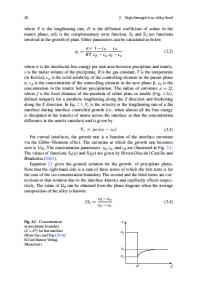Improving the Strength of Friction-Stir-Welded Joints of AA1100 Alloy
- PDF / 4,766,918 Bytes
- 12 Pages / 593.972 x 792 pts Page_size
- 35 Downloads / 367 Views
JMEPEG https://doi.org/10.1007/s11665-020-05331-6
Improving the Strength of Friction-Stir-Welded Joints of AA1100 Alloy N. Pallavi Senapati
and R.K. Bhoi
Submitted: 30 July 2020 / Revised: 29 October 2020 / Accepted: 1 November 2020 This paper deals with the experimental analysis of Friction Stir Welding (FSW) of AA1100 aluminum alloy joined by means of a square pin tool. During the process, temperature measurement has been done by means of K-type thermocouples and it has been noticed that the temperature in the advancing side (AS) of the weld is about 20-25 °C higher than its retreating side (RS). The ultimate tensile strength (UTS) of the welded specimen is increased by 20% of the parent material due to the uniform dispersion of silicon particles present within the base material. Microstructural observations revealed finely arranged equiaxed grains in the nugget region of the weld. X-ray diffraction results showed the formation of alumina (Al2O3) in the weld nugget due to high heat generation and exposure to atmospheric oxygen during welding. Residual stress measurement exhibited a M-shaped distribution. The samples joined at low travel speed and high tool rotational speed showed compressive residual stress in the joint region. Residual stress of the material lying below the tool shoulder is found to be tensile in nature. Also, it has been noticed that the residual stress in the AS is superior in magnitude than the RS of the weld specimen. Keywords
friction stir welding, grain size, phase analysis, residual stress, ultimate tensile strength, x-ray diffraction
1. Introduction Friction stir welding (FSW) is a solid-state fusion technique developed at The Welding Institute in 1991. Since then, this procedure is gaining huge attention globally because of its various advantages over traditional welding process, particularly its capability to join metals and alloys like aluminum and its alloys. Over the last few years, academicians and researchers are being interested in using FSW technique for such metals and alloys due to its ability to produce higher quality solid state joints. As there is no melting in the base metal during welding, the temperature gradients are significantly lesser than those experienced in conventional fusion methods and the resulting residual thermal stresses are supposed to be low as well. The restriction to movement caused by the firm clamping of the workpieces can also result in a remarkable increase in residual stresses (Ref 1). Like other production techniques, FSW also gives rise to the residual stresses generated by the thermal cycles, mechanical deformation and motion constraints used in the welding process that can considerably influence the properties of the joint to be produced (Ref 2). Basically, residual stresses may be tensile or compressive in nature. Higher values of tensile residual stresses in the weld specimen are not desirable due to their adverse influence on the mechanical properties of the specimen that may lead to service failure without any warning (Ref 3, 4). Thus, vari
Data Loading...











